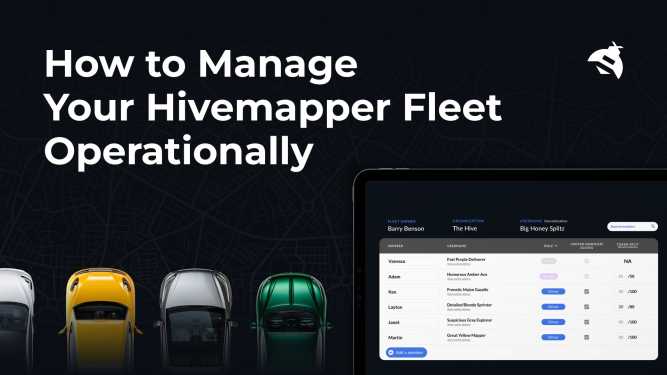The Latest Buzz
Map Mining, Anyone? How Mapping on the Blockchain Will Bridge Crypto to the Physical World

Hivemapper Co-Founder & CEO Ariel Seidman joined Amir Haleem, Co-Founder of Helium, and Tushar Jain, Managing Partner, Multicoin Capital, on stage at the Multicoin Summit 2021. Watch the video for their expertise and take on how crypto incentives can be leveraged to build and deploy physical infrastructure in the real world.
How did you get into maps?
Ariel Seidman led the maps team at Yahoo when it was still competitive with Google Maps in 2006–2007. “Google was investing billions of dollars into collecting massive amounts of data. Yahoo for a variety of bad reasons was not interested in playing that game,” Seidman said. Yahoo started to lose and as a competitive person Seidman was frustrated with this. He was certain that there must be a more cost effective way to build a map.
How did you come up with the idea for Hivemapper?
In 2009, Seidman founded Gigwalk, a distributed data collection network that grew to about 2 million users. Seidman left Gigwalk and learnings from this experience inspired the idea for his next venture. “How do you truly build a global map?” Seidman wondered. He came up with the idea for a distributed network of contributors that collect map data. Initially, drones served as the collection hardware. His team faced the challenges of poor battery life and a lot of regulation around drones. When they switched over to dashcams, the contributor network and map coverage started to grow. It became a product that scales–Hivemapper.
What is Hivemapper’s financial business model?
“The financial business model we had initially wasn’t great,” Seidman said. He came across Helium and was introduced to Helium’s co-founder Amir Haleem. Seidman found Helium’s decentralized system “super interesting” and wondered, “Can we apply this crypto concept to incentivize the creation of the global map we’re building?”
How does Hivemapper work?
Hivemapper is building a decentralized global map. Contributors collect imagery via forward- or side-facing 4K dashcams. This imagery is transformed into an up-to-date, high resolution, and relevant global map. The world is broken up into tiles and contributors get rewards for tiles. Today, contributors are paid in cash in several markets. In 2022, Hivemapper will move to a crypto model and launch a token called HONEY. On the other side, are the consumers who buy map APIs. The map API is currently basic, but over time Hivemaper will add driving directions, geocoder, and other data.
Let’s back up. How are maps created?
There are a couple of different approaches to building a map at a global scale. “Most people don’t realize that there’s actually only one global map. Maybe one and a half,” Seidman said. Google Maps has global coverage while Apple Maps does not have global coverage to this day.
The Google Maps approach
The Google Maps approach is very expensive. Each Google Street View car costs about half a million dollars. Google also owns a lot of airplanes to collect aerial imagery for their “satellite view” and to build 3D maps for Google Earth. “Very, very, very centralized. Apple basically just did a copy-and-paste on that and they’re just throwing money at the problem,” Seidman said.
The unpaid crowdsourcing approach
The second approach is unpaid crowdsourcing like OpenStreetMap. OpenStreetMap started in 2004 and didn’t get the coverage necessary to serve most use cases until about 2014. “While this approach has merit, it just takes a really, really, really long time,” Seidman said. “And you still end up in the situation where you have coverage that’s spotty. For example, there’s a very strong German community that has mapped all these interesting small German villages and towns but isn’t interested in El Salvador for whatever reason.”
The paid crowdsourcing approach
The third approach is paid crowdsourcing. Keeping a global map up to date is very challenging. “If you’re dependent on a group that’s really hard to incentivize, the map decays very quickly,” Seidman said. “We’ve tried all three of these approaches to a certain extent. When you pay people that relationship becomes incredibly adversarial. You know that a company naturally wants to improve its margins over time. So what do they do? They stop paying contributors as much. The contributors understandably get really pissed off.”
Why did you end up in crypto?
“When I started looking at Helium, I saw that its decentralized system solves a lot of interesting problems,” Seidman said. The contributors and the company are on the same team and they share the value they create for building the network. If Hivemapper just continues to pay its contributors cash per map tile and Google or Amazon decides to duplicate Hivemapper’s approach and offer more cash per map tile, contributors would go there. But with crypto, contributors own tokens and if they start mapping for another network, they would effectively be diminishing the value of the map they’ve built.” Crypto is a way to protect the integrity of a mapping network.
“A lot of people don’t realize that Google Maps, in addition to serving you as a consumer, serves over five million app developers,” Seidman said. Google Maps is embedded in a variety of applications and they’re paying Google Maps for using their API.
Why is credible neutrality important?
There are 7.9 billion people on our planet. “No person or company owns our planet. It’s important for all of us who live on this Earth that no one entity controls the map of Earth. So it’s an important concept and a lot of other people also believe in this idea,” Seidman said.
You can view credible neutrality from different perspectives. From a business perspective, FedEx or Uber is not going to trust their critical infrastructure and logistics information in a startup that could disappear tomorrow. It doesn’t matter if the startup raised 20 million or 200 million. Maps are hard to build and customers don’t want to take chances on a little startup.
However, building a decentralized mapping network ensures that it continues to thrive regardless of what happens to the startup that started it. This makes the sales process easier. “Even if Hivemapper Inc disappears tomorrow, there’s still a mapping network that will continue to produce data for you and you could potentially go and get mapping APIs or build the mapping APIs yourself to pull all the data necessary,” Seidman said.
Why is community important for Hivemapper?
Rideshare and delivery drivers
Hivemapper’s community has multiple modes of contribution. The primary mode is through dashcams. “We primarily focus on two groups when it comes to the dashcam,” Seidman said. One is Uber drivers, Lyft drivers, and delivery drivers. These are people who are already on the road and it’s a way for them to earn rewards for miles they're already driving.
Mapping and GIS enthusiasts
Another group is mapping and GIS enthusiasts. “They love to just build maps, watch maps grow, and annotate. They go out and buy dashcams. What’s interesting about this group is they like to turn it into a game or challenge. They’re not just interested in driving down Broadway. They want to go into all the little back alleys and all the weird locations. This turns out to be really valuable in terms of building out global coverage. There are a lot of people who drive up and down Broadway but there are not that many people who go into all these like little nooks and crannies that are really valuable especially for logistics use cases,” Seidman said.
Map annotators
Hivemapper will add another layer of contribution via map annotators. Map annotators will be defining building boundaries, correcting addresses, marking one way streets, just to name a few.
“Unbeknownst to most people, Waze has about 25,000 map annotators. I don’t think they realize that Waze is owned by Google and they’re actually working for a company that’s worth two trillion dollars for free,” Seidman said. “I’m very excited to introduce Hivemapper to that community because I think that the economic equation is going to be a lot more rewarding for them.”
Hivemapper’s top performing market
Like the early days of Helium, Hivemapper is also currently focused on a few markets. Hivemapper’s best performing market is Manila where the community grew through word-of-mouth. “One Uber driver brought in his sister who brought somebody else who’s a delivery driver and so on,” Seidman said. “They host Hivemapper dinners every month and geek out about mapping. They send us pictures with their names and we tell them we don’t want their names to protect their privacy.
”How is Hivemapper more cost-effective?“
If you take University Avenue in Palo Alto, kind of Google’s backyard, Google Street View cars see University Avenue roughly every 12 months,” Seidman said. “We can see that same street literally every day. And it would still be orders of magnitude cheaper than running a Google Street View car. In other parts of the world, it’s a lot worse. If you go to Lagos, Nigeria, which is a massive city, it’s maybe every 36 months. So our approach opens up a lot of opportunities for additional use cases. From a commercial real estate perspective, seeing how traffic flows in and out of buildings and what kinds of cars are around is valuable.
”What are new use cases that excite you?“
I’m interested in seeing how this gets applied in augmented reality because you have to augment objects. For example, you take a lizard and you put it on a park bench. If that park bench isn’t there anymore, the whole effect gets lost,” Seidman said.
If you’d like to learn more about the Hivemapper blockchain, cryptocurrency Honey (HONEY), and Open Dashcam, email us at [email protected] with the subject line “Hivemapper Network Strategy” and we’ll send you more information.
We’re hiring! Are you a software developer and interested in joining a Web3 company? Check out open positions here.
Share Post



